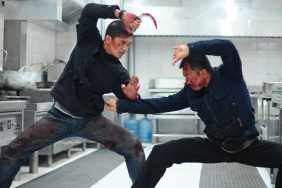A few weeks back, I, your humble professor here on Crave Online’s Free Film School, implored you to stay through the credits, and ponder the scads of people who work on a film. The intent of the exercise was to get you thinking of what goes into filmmaking, and how many tiny specialized fields are required to put something together as sprawling, time-consuming, and expensive as a feature film. If you did your homework (and you’re doing the homework assignments, right? I’d hate to have to call your parents), you probably noticed an entire chunk of the film’s credits devoted to something called The 2nd Unit. There are 2nd Unit directors, 2nd Unit photographers, 2nd Unit gaffers, and 2nd Unit assistants. What, I hear you cry from the back of my classroom (which is, in actuality, your home or office), in the name of Sam Hill, is the 2nd Unit?
Allow me to elucidate. The 2nd Unit is (to offer a brief definition) the secondary film crew (and it is indeed an entire crew in itself) that is mostly devoted to filming anything that doesn’t directly involve the film’s main stars.
So yes, anything you watch that doesn’t have a speaking actor on screen is likely going to be done by the 2nd Unit. An establishing shot of a building’s exterior will be shot by the secondary crew while the primary crew is back at the studio shooting the interiors. This is a hugely efficient way to work, as it allows the film to be shot in half the time. The primary director is often too busy working with actors and consulting designers and photographers to shoot, say, a short shot of what the hero is looking at across a pond. That brief shot would be left to the second unit. I hate to snuff out some of the wonder, or throw a wrench into the grinding minds of any of the more devout young film students who subscribe a little too religiously to the auteur theory, but in many cases, a large chunk of the film (anywhere from 25% to 75%) can be shot entirely by the 2nd Unit.

As such, I think they deserve a Film School lesson for themselves. Especially right at the end of summer, when you just got done seeing dozens of high-budget action films. You see, action scenes, fight scenes, stunt scenes, and car chases are often the work of the 2nd Unit. They are the ones who work with the stuntmen, the fight choreographers, and the professional drivers. They are the ones who film the explosions and the crashes. In a way, they are the ones who are getting their hands dirty: there seems to be a lot more tinkering and heavy lifting in the 2nd Unit. Spielberg may have been the mastermind and decision maker on a great film like Raiders of the Lost Ark, but it was the second unit (headed up by one Michael D. Moore) that made sure the truck was travelling at the right speed while Harrison Ford (or more likely his then-stunt double, Vic Armstrong, who is himself now a 2nd Unit director) dragged behind it. This is not to say the primary director is absent from a lot of these scenes; some directors are very hands-on with the second unit photography. But their role on 2nd Unit shooting is more a role of overseer, and not one of construction worker.

If you’re a fan of action films, then you’re a fan of the 2nd Unit already. Consider, to cite another example, the freeway chase in The Matrix Reloaded. This is an extended and noisy action scene where characters leap from speeding car to speeding car, firing guns, punching one another, and ultimately having a kung fu showdown on the top of a Big Rig. The look and tone of the film was likely decided by The Wachowskis, but the actual choreography, shooting, and camera angles were decided by ex-stuntman David R. Ellis, the 2nd Unit director. The entire sequence, which required the construction of a length of freeway, was in the hands of Mr. Ellis and his capable eye for what stuntmen are capable of. Indeed, most action film 2nd Unit directors were once stuntmen, and many directors were once 2nd Unit directors. David R. Ellis went on to direct films like Snakes on a Plane, Cellular and last week’s Shark Night 3D.

The 2nd Unit director will also have some pretty thankless tasks, filming what is typically referred to as “pickups.” They sometimes film supporting actors’ reaction shots and the like. When a two-person conversation is filmed, directors will typically film the entire scene looking at one actor, and then do it a second time looking at the other. For such scenes, the actor not on camera sometimes employs a stand-in so there is at least a shoulder in the shot. There are a few actor-friendly directors out there who like to film both actors simultaneously with two cameras (retired actor Alex Winter employed this technique in his obscure 1999 noir film Fever), but, for the most part, it’s one-at-a-time (although the practice is becoming more common with the popularity of cheaper digital cinematography). The 2nd Unit will sometimes shoot these scenes. Often you can tell, through the clever editing, if there are two actors on the set together, or if they filmed their scenes separately. Watch the famous scene in The Expendables, for example, where Bruce Willis, Arnold Schwarzenegger, and Sylvester Stallone have a conversation. You may note that Willis is never in the same shot as the other two, meaning he likely filmed his scenes on a different day. Further inspection of the scene proves that Schwarzenegger doesn’t quite look Stallone in the eye, and his body seems to be lit a little differently, betraying the fact that Stallone filmed him on a blue screen on a different day. The dialogue flows weirdly in that scene as a result. I think its clunkiness is charming, but others have noted how distracting the overall effect is. But I digress.
I learn from some cursory internet research that Christopher Nolan, on most of his films, prefers to work with his actors and sets hands-on, and tries to stay away from 2nd Unit photography altogether. This is an admirable approach, as it ensures that one man is in charge of all aspects of a film. Nolan, however, is an immensely successful director, thanks to his Batman films, and is one of the few big-budget directors who is allowed such a luxury. In order to get shooting done as quickly and as efficiently as possible, a 2nd Unit is often downright necessary. The Lord of the Rings movies often had multiple units, more than two, anyway, working simultaneously, because of the vast scope of the production.
So the next time you’re marveling to an excellent chase scene, or cheering a superhero battle, remember that the 2nd Unit director was probably more hands-on than anyone else. Give these hard-working filmmakers some credit. They create more than you think.
HOMEWORK FOR THE WEEK: Again, I reiterate: The next film you see in theaters, stay for the credits. Note who the 2nd Unit director was, and note how many people work on the 2nd Unit team. Look them up on IMDb and see what other films they contributed to. Try this: think up a movie scene in your mind. Something simple, like a two-person conversation. Then think how you would film it, had you only one camera. Would you edit a lot? Focus more on one character? Now try to film the scene in your head as quickly as you possibly can. How would you budget your filming time? If you’re feeling particularly ambitious, actually film and edit something. How much easier would it have been, had you another cameraman also working on it with a second camera? What would be lost in using a second camera? Gained?







